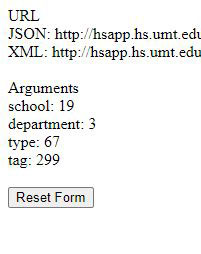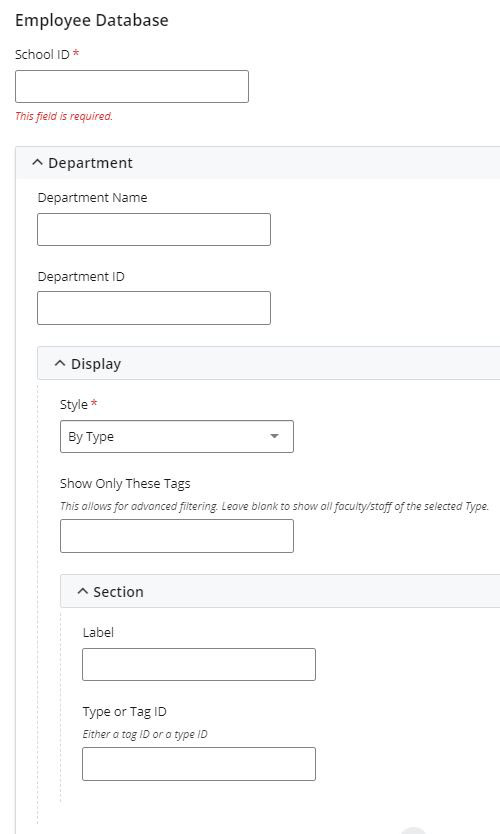Employee Database
How It Works
The employee database and its API Plugin are tools that can be used in conjunction with one another to display information about employees in campus departments. This page will walk you through using the Employee Database block on your page to display employee information.
Instructions
- Create the "Employee Database" block and add it to your site.
- Go to "Add Content" > "Blocks" > "Row Blocks" and select the "Employee Database" Block.
- Navigate to the Employee Database API Plugin and retrieve the numerical codes to enter into the Block.
- Select the "School" or "College" you are looking for.
- Select the "Department" you are looking for.
- Select the "Type" of employee you are looking for.
- Select the "Tag" associated with that employee Note: Some departments don't use tags, the query will revert to "Type" if this is the case.
- Take note of the numerical values of the School/College, Department, Type and Tag produced by the API.
- Back in Cascade, edit the "Employee Database" block you created. Enter the information generated from the API into the appropriate fields.
- Submit your changes.
- Publish your changes. NB: the Employee Database block does not display fully in Cascade, but only on the live site. Cascade will only display the numerical values retrieved from the API.
Breakdown of the API codes.
- School ID: Each school within the database is referenced by a unique ID.
- Department ID: In combination with the school ID, this identifies your department within the Faculty Database.
- ID(s): Each person in the system is associated with a personnel "type" (Professor, Adjunct, Staff, etc.), and you can filter by these IDs.
- Tag ID(s): Some departments choose to further categorize by research area or specialty with tags.


The section below is an example of what you should see after attaching the employee database block.
Ardi Kia
Professor, Director of the Central and Southwest Asian Studies Program
Contact
- Office
- Stone Hall 303B
- ardi.kia@mso.umt.edu
- Office Hours
Monday, Wednesday, Friday from 9:00 a.m.- 11:00 a.m.
and by appointment.
- Website
- http://umt.edu/cswa/default.aspx
Education
A.S, B.F.A., B.A., M.A.. M.A. Ph.D. University of Wisconsin-Madison, Dean's Honors list
Courses Taught
ANTY 141H: Silk Road
ANTY 241H: Central Asian Civilizations and Cultures: Peoples and Environments
ANTY 347: Central Asia and its Neighbors
ANTY 442: Cities and Landscapes of Central Asia
ANTY 444: Artistic Traditions of Central Asia
ANTY 494: Seminar on Central Asia
Teaching Experience
28 years teaching and advising at the University of Montana-Missoula
Selected Publications
Artistic Traditions of Inner Eurasian Cultures, Prehistoric, Ancient, and Medieval Golden Ages, (Manuscript Published by Lexington Books, An imprint of The Rowman & Littlefield Publishing Group, 2022).
Central Asian Cultures, Arts and Architecture, Second Edition, Inner Eurasia from Prehistory to the Medieval Golden Ages, (Manuscript Published by Lexington Books, An imprint of The Rowman & Littlefield Publishing Group, 2018).
Cultures of Central Asia: Between 2016 – 2021, seven volumes (5 – 11) of the Journal of Central Asian Cultures have been published at the University of Montana. The topics of the journal include analysis of Inner Eurasia history, cultures and specific issues across prehistory, ancient, medieval and modern eras The journal has included articles by faculty and students in the CSWA Program.
Central Asian Cultures, Arts and Architecture, (Manuscript Published by Lexington Books, An imprint of The Rowman & Littlefield Publishing Group, 2015).
Silk Road, (Manuscript Published: Fall 2014)
Ardi Kia
(Co-authors: A group of International Scholars)
Discovering Central Asia, (Manuscript Published: Spring 2012)
US Department of Education
Ardi Kia
(Co-authors: Mehrdad Kia, Don Beduna, Jim Sears, Marc Hendricks, Rick and Susie Graetz)
Specialized Skills
Art History; Central Asia

